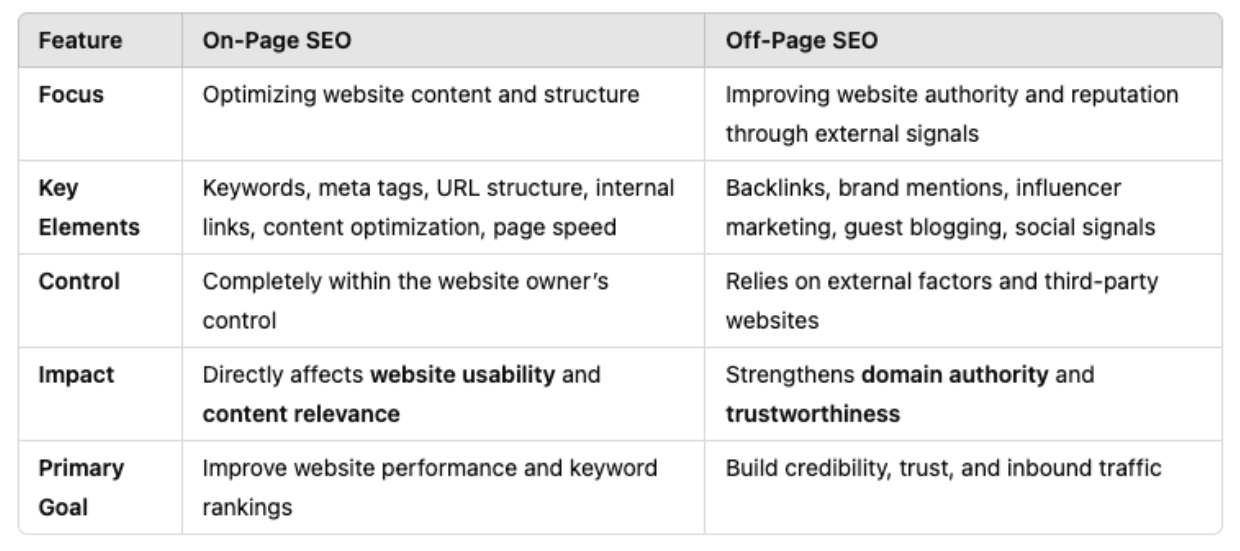Search engine optimization (SEO) is the backbone of digital marketing, shaping how businesses gain visibility online. Whether you’re running an e-commerce store, a local service business, or a content-driven website, SEO determines how easily potential customers can find you in search results. But SEO isn’t just about stuffing keywords into your content and hoping for the best—it’s a strategic process with multiple layers. At its core, SEO is divided into on-page SEO vs. off-page SEO. These two components work together to improve your website’s search engine rankings, but they focus on very different aspects of optimization. On-page SEO is all about what happens directly on your website—things like optimizing content, improving site structure, and enhancing user experience. Off-page SEO, on the other hand, takes place outside your site, focusing on backlinks, brand mentions, and external signals that boost your site’s credibility.

Boost your website conversions!
Improve your on-page SEO and climb search rankings! Let Culture Red craft an SEO plan that gets your site found! Contact us now for a free consultation!

There’s also technical SEO, which acts as the foundation of both on-page and off-page strategies. It ensures that search engines can crawl, index, and understand your website efficiently, impacting everything from page speed to mobile-friendliness.
In this post, we’ll break down on-page vs. off-page SEO, providing real examples, actionable techniques, and key differences between the two. Whether you’re a business owner, marketer, or SEO strategist, understanding how to balance both elements is crucial for long-term success in search rankings.
What is On-Page SEO?
On-page SEO refers to the optimization strategies implemented directly on a website to improve its search rankings. It involves refining content, structure, and technical aspects to make a website more search-engine-friendly. Unlike off-page SEO, which relies on external factors like backlinks and social signals, on-page SEO is entirely within your control.
Why Is On-Page SEO Essential?
Search engines like Google prioritize websites that provide valuable, relevant, and user-friendly content. On-page SEO helps search engines understand what your pages are about, making it easier to rank for relevant keywords. A well-optimized page can lead to higher rankings, increased traffic, and better user engagement, all of which contribute to higher conversions and revenue.
Studies show that 75% of users never scroll past the first page of search results (Backlinko). If your site isn’t optimized properly, it’s unlikely to reach the audience you’re targeting. That’s why on-page SEO is critical—it enhances visibility and ensures your site stands out in a crowded digital landscape.
Key Elements of On-Page SEO
To fully optimize your website, you need to focus on several critical on-page SEO elements:
1. Title Tags
Title tags are one of the most important on-page SEO factors. They tell both users and search engines what a page is about. Each page should have a unique and keyword-rich title tag, ideally under 60 characters to ensure full display in search results.
For example, instead of “SEO Tips,” a more optimized title tag could be “10 Essential SEO Tips to Boost Your Rankings in 2025.”
2. Meta Descriptions
Meta descriptions provide a brief summary of a page’s content. While they don’t directly impact rankings, they influence click-through rates (CTR), which can indirectly boost SEO performance.
An effective meta description should:
- Be under 158 characters
- Include a primary keyword naturally
- Encourage users to click by highlighting unique value
For instance, an optimized meta description for this post could be:
“Learn the key differences between on-page and off-page SEO, plus expert tips to improve rankings and grow your website traffic in 2025!”
3. Headers (H1, H2, H3, etc.)
Headers structure your content, making it easier for both users and search engines to read and understand. The H1 tag should contain your primary keyword and clearly define the page’s topic. Subsequent H2 and H3 headers break content into digestible sections, improving readability and SEO.
For example, in this article, we use H2 headers to structure main sections and H3 headers for subtopics like title tags and internal linking.
4. Keyword Optimization
Keywords are the foundation of SEO, but keyword stuffing is outdated and can harm rankings. Instead, focus on natural keyword integration within:
- Page titles and headings
- The first 100 words of content
- Image alt text
- URLs
Long-tail keywords (phrases with three or more words) often perform better because they match specific search intent. For instance, “on-page SEO tips for beginners” is more effective than simply “SEO tips.”
5. Internal Linking
Internal links connect pages within your website, helping search engines understand site structure and distributing link authority. They also improve user experience, guiding visitors to relevant content.
A strong internal linking strategy should:
- Use descriptive anchor text instead of generic phrases like “click here”
- Link to relevant, high-quality content
- Avoid excessive links on a single page (Google advises keeping it reasonable)
6. Image Optimization
Images enhance user engagement but can slow down a site if not optimized properly. Optimized images contribute to SEO by:
- Reducing page load time (Google prioritizes fast-loading websites)
- Improving image search rankings
- Enhancing accessibility with alt text
Best practices for image SEO include:
- Compressing images to reduce file size without sacrificing quality
- Naming files descriptively (e.g., on-page-seo-guide.jpg instead of IMG001.jpg)
- Using alt text to describe the image for both search engines and visually impaired users
On-page SEO is crucial for increasing search visibility and ensuring your content reaches the right audience. By optimizing title tags, meta descriptions, headers, keywords, internal links, and images, you create a search-friendly and user-friendly experience.
On-Page SEO Techniques
Effective on-page SEO requires more than just inserting keywords into your content. It involves strategic optimizations that improve readability, usability, and technical performance. Below, we’ll explore key techniques that enhance search rankings, user engagement, and overall website performance.
Best Practices for Optimizing Content
High-quality content is the cornerstone of on-page SEO. Search engines prioritize pages that provide valuable and relevant information, making content optimization essential. Here’s how to do it right:
- Write for Humans First, Then Search Engines – Content should be engaging, informative, and easy to read. Avoid keyword stuffing and focus on solving the user’s query.
- Use Keyword Variations & Synonyms – Google’s algorithm understands context. Instead of repeating the same keyword, incorporate semantic variations (e.g., “SEO strategies” instead of “SEO techniques”).
- Answer Search Intent Clearly – Content should align with what users are looking for. Are they seeking a guide, a product review, or a comparison? Tailor content accordingly.
- Incorporate Visuals & Media – Images, infographics, and videos boost engagement and time spent on a page, both of which can improve rankings.
- Optimize for Featured Snippets – Formatting content into bullet points, numbered lists, and concise paragraphs increases the chance of being displayed in Google’s featured snippets.
A 2023 study found that 68% of online experiences begin with a search engine, reinforcing the importance of well-optimized content (BrightEdge, 2023).
The Role of Structured Data & Schema Markup
Structured data helps search engines understand your content better, which can lead to rich results (like star ratings, product prices, and event details) in search results. Schema markup is a type of structured data that provides additional context about your page.
Why Schema Markup Matters:
- Helps Google display rich snippets that increase click-through rates.
- Improves how product pages, reviews, and events appear in search results.
- Enhances voice search optimization by making content more readable for AI assistants like Siri and Google Assistant.
Common Types of Schema Markup for SEO:
- Article Schema (for blog posts and news)
- FAQ Schema (for frequently asked questions)
- Product Schema (for e-commerce product listings)
- Review Schema (for displaying star ratings in search results)
Adding structured data doesn’t directly improve rankings, but studies show that rich snippets increase organic CTR by up to 30% (Moz, 2023).
User Experience (UX) & Mobile-Friendliness
Google’s algorithm prioritizes user experience (UX) as a ranking factor. A site that’s difficult to navigate or loads slowly will struggle to rank, even with great content.
Key UX & Mobile Optimization Techniques:
- Mobile Responsiveness – Over 60% of global website traffic comes from mobile devices (Whatsthebigdata.com, 2024). Google uses mobile-first indexing, meaning the mobile version of your site matters more than the desktop version.
- Page Speed Optimization – Slow-loading pages increase bounce rates. Compressing images, enabling browser caching, and using a content delivery network (CDN) can significantly improve load times.
- Clear Navigation & Readability – Websites should be easy to navigate, with logical menus and legible fonts. Break up text with headers, bullet points, and white space.
- Avoid Intrusive Pop-Ups – Google penalizes sites that use intrusive interstitials (annoying pop-ups) that obstruct content, especially on mobile.
In 2023, Google reported that 53% of mobile users abandon a site if it takes longer than 3 seconds to load (Shopify.com). Prioritizing UX ensures visitors stay engaged, reducing bounce rates and boosting SEO performance.
Optimizing content, leveraging structured data, and enhancing user experience are essential on-page SEO techniques that directly influence rankings and user engagement. By focusing on these strategies, websites can achieve better search visibility, higher click-through rates, and improved overall performance.
Next, we’ll explore off-page SEO techniques and how they complement on-page efforts to maximize website authority and rankings.
Off-Page SEO
While on-page SEO focuses on optimizing elements within your website, off-page SEO refers to external factors that influence your site’s rankings. These external signals—like backlinks, brand mentions, and social proof—help search engines determine your site’s authority, credibility, and relevance.
Why Off-Page SEO Matters
Off-page SEO is crucial because it tells search engines how trustworthy and valuable your site is within your industry. Google’s algorithm considers hundreds of ranking factors, but off-page elements—particularly backlinks—are among the most influential.
Think of it this way: If multiple reputable websites link to your content, search engines see your site as authoritative and relevant. This is similar to how academic papers gain credibility when cited by other experts. A strong off-page SEO strategy can:
- Improve search rankings
- Increase website traffic
- Strengthen brand credibility
- Drive more conversions
A 2023 study found that off-page factors account for approximately 50% of Google’s ranking considerations (Moz, 2023). Without off-page SEO, even the most well-optimized website may struggle to rank against competitors with stronger external signals.
How Off-Page SEO Builds Authority and Trust
Google uses E-E-A-T (Experience, Expertise, Authoritativeness, and Trustworthiness) as a framework for evaluating web pages. Off-page SEO plays a major role in establishing a site’s credibility, particularly through:
- High-quality backlinks (signals of authority)
- Brand mentions on reputable sites
- Positive reviews and online reputation management
- Social signals from shared content and engagement
The more Google perceives your site as trustworthy and authoritative, the higher your chances of ranking for competitive keywords.
The Role of Backlinks in Off-Page SEO
Backlinks—also called inbound links—are links from other websites that point to your site. Google considers these as votes of confidence. However, not all backlinks are equal.
Types of Backlinks & Their Impact
- High-Quality Backlinks – Links from authoritative, industry-relevant sites (e.g., Forbes, HubSpot) boost rankings significantly.
- Low-Quality or Spammy Backlinks – Links from irrelevant, low-authority, or spammy sites can hurt rankings and even lead to Google penalties (Ahrefs, 2025).
- Natural vs. Artificial Backlinks – Google prefers organic backlinks gained through valuable content rather than paid or manipulative link-building tactics.
Why Backlinks Matter for SEO
- Websites with high-quality backlinks rank significantly higher in search results. In fact, the top-ranking pages on Google have an average of 3.8 times more backlinks than lower-ranking pages (Ahrefs, 2025).
- Backlinks help search engines discover new pages faster by following links from indexed pages.
- Strong backlinks improve domain authority (DA), making it easier to rank for competitive keywords.
A recent study found that 68% of online experiences begin with a search engine (BrightEdge, 2023), reinforcing the importance of strong SEO strategies, including off-page SEO efforts.
Off-page SEO is a powerful factor in building website authority and increasing rankings. By earning high-quality backlinks, establishing trust through brand mentions, and maintaining a strong online reputation, your site can climb the search rankings more effectively.
Next, we’ll explore off-page SEO techniques to help you implement a winning strategy for sustainable growth.
On-Page vs. Off-Page SEO: Key Differences
Understanding the distinction between on-page SEO and off-page SEO is essential for building a well-rounded digital marketing strategy. While both play critical roles in boosting your website’s visibility, they focus on different aspects of optimization. Below, we’ll explore their key differences, which approach is best for various business goals, and why a balanced SEO strategy should incorporate both.

Which SEO Strategy Is Best for Different Business Goals?
The choice between on-page SEO and off-page SEO depends on specific business objectives.
- For New Websites & Startups
If your website is new, start with on-page SEO. Google needs to understand your content before it can rank it. Optimizing page structure, meta tags, and keyword placement will ensure your site is search engine-friendly. - For Competitive Niches
Businesses in highly competitive industries (such as finance, health, and e-commerce) benefit from off-page SEO strategies like backlink building and influencer outreach to boost domain authority. - For Local Businesses
Citation building, local backlinks, and brand mentions play a major role in local SEO success. On-page SEO should include location-based keywords, while off-page efforts should focus on Google Business Profile optimization and directory listings (BrightLocal, 2023). - For Long-Term Growth
The most effective SEO strategy combines both on-page and off-page efforts. On-page SEO ensures content is valuable and accessible, while off-page SEO builds trust and credibility, ultimately leading to sustained search engine success (Moz, 2023).
Why You Need Both for a Strong SEO Strategy
While on-page SEO is the foundation of any good SEO strategy, off-page SEO is what sets your site apart in search rankings. A well-optimized website without backlinks may struggle to gain visibility, while a site with strong external links but poor on-page optimization may not convert visitors effectively.
A 2023 study found that websites ranking in the top three positions on Google had 3.8x more backlinks than lower-ranking pages, highlighting the importance of off-page factors (Ahrefs, 2023). However, Google’s algorithm also prioritizes user experience, content quality, and page speed, which are all on-page SEO factors (Search Engine Journal, 2023).
To maximize search engine rankings and organic traffic, businesses should invest in both on-page and off-page SEO. While on-page optimization ensures content is discoverable and user-friendly, off-page efforts build the authority needed to compete for top search rankings.
Next, we’ll dive into technical SEO and how it connects on-page and off-page efforts to improve your website’s overall performance.
The Role of Technical SEO
While on-page SEO focuses on content optimization and off-page SEO builds website authority, technical SEO acts as the foundation that ensures search engines can crawl, index, and understand your site. Without a solid technical SEO structure, even the best content and backlink profile won’t be enough to rank effectively.
How Technical SEO Connects On-Page and Off-Page SEO
Technical SEO supports both on-page and off-page SEO efforts by ensuring that search engines can efficiently process and rank a website’s content. Here’s how:
- On-Page SEO Connection: Technical SEO improves factors like page speed, structured data, and mobile-friendliness, making it easier for search engines to understand and rank your content.
- Off-Page SEO Connection: A well-optimized site with fast load times and secure protocols (HTTPS) is more likely to earn high-quality backlinks, as other websites prefer linking to pages with strong usability and security.
A study by Google in 2023 found that 53% of mobile users abandon a website if it takes longer than three seconds to load (Think with Google, 2023). This highlights how technical SEO directly impacts user retention and search rankings.
Key Elements of Technical SEO
To ensure your website is both search engine-friendly and user-friendly, focus on these core areas of technical SEO:
1. Site Speed Optimization
Page speed is a major ranking factor, as Google prioritizes fast-loading websites. A slow website not only affects rankings but also increases bounce rates.
Ways to improve site speed:
- Use a Content Delivery Network (CDN) to serve content faster.
- Compress images and use modern formats like WebP.
- Enable browser caching to speed up repeat visits.
- Minimize unnecessary JavaScript and CSS files.
A 2023 report by Backlinko found that the average page load time for a first-page Google result was 1.65 seconds, reinforcing the need for speed optimization (Backlinko, 2023).
2. Indexing & Crawlability
For search engines to rank a page, they must first crawl and index it. If Google can’t properly access your pages, they won’t appear in search results.
Best practices for indexing and crawlability:
- Use robots.txt to guide search engine crawlers.
- Submit an XML sitemap to Google Search Console.
- Avoid duplicate content issues by implementing canonical tags.
- Fix broken links and 404 errors to improve user experience.
A 2023 study by Ahrefs found that 96% of all web pages never receive organic traffic due to indexing issues, further emphasizing the importance of technical SEO audits (Ahrefs, 2023).
3. Structured Data & Schema Markup
Structured data helps search engines understand the context of your content, enabling features like rich snippets (e.g., star ratings, event details, FAQs).
Benefits of schema markup:
- Increases click-through rates (CTR) by enhancing search results.
- Improves voice search optimization, making content easier to find via Google Assistant, Alexa, and Siri.
- Helps Google categorize pages, boosting rankings for relevant queries.
According to a Search Engine Journal study, pages with structured data see a 30% increase in organic CTR compared to pages without it (Search Engine Journal, 2023).
Technical SEO acts as the bridge between on-page and off-page SEO, ensuring your site is fast, crawlable, and structured correctly for search engines. By optimizing site speed, indexing, and structured data, you create a strong technical foundation that supports higher rankings, better user experience, and increased organic traffic.

Boost your website conversions!
Elevate your brand with a lead-producing site that drives results. Contact us now for a free consultation!

How Technical SEO Connects On-Page and Off-Page SEO
Technical SEO bridges the gap between on-page and off-page strategies:
- On-Page SEO Connection: By optimizing elements like site speed, mobile-friendliness, and structured data, technical SEO enhances user experience and content accessibility, which are crucial for on-page success.
- Off-Page SEO Connection: A technically sound website is more likely to attract high-quality backlinks, as external sites prefer linking to reliable and efficient platforms.
Key Elements of Technical SEO
Focusing on the following components can significantly improve your website’s technical health:
1. Site Speed Optimization
Page load time is critical; 53% of mobile users abandon sites that take longer than 3 seconds to load. (Google Business)
Strategies to Enhance Site Speed:
- Image Optimization: Compress images to reduce load times.
- Browser Caching: Enable caching to allow browsers to store frequently used resources.
- Minify Code: Reduce the size of CSS, JavaScript, and HTML files.
2. Indexing and Crawlability
Ensuring search engines can efficiently crawl and index your site is vital for visibility.
Best Practices:
- XML Sitemaps: Create and submit sitemaps to guide search engines.
- Robots.txt File: Use this file to manage crawler access to certain parts of your site.
- Fix Broken Links: Regularly check for and repair broken links to maintain site integrity.
3. Structured Data and Schema Markup
Implementing structured data helps search engines understand your content, increasing the likelihood of rich snippets.
Benefits:
- Enhanced Visibility: Rich snippets can improve click-through rates by up to 30%.(POPSuite)
- Better SERP Positioning: Proper schema markup can lead to more prominent placement in search results.
By addressing these technical aspects, you create a solid foundation that supports both your on-page content and off-page SEO efforts, leading to improved search engine rankings and user engagement.
FAQs & Common SEO Questions
Understanding the nuances of SEO is crucial for developing an effective digital marketing strategy. Below are answers to some common questions that clarify the distinctions and applications of various SEO practices.
Q: What is the difference between onsite and offsite SEO?
Onsite SEO, also known as on-page SEO, involves optimizing elements within your website to improve its search engine rankings. This includes content creation, keyword optimization, meta tags, internal linking, and ensuring a user-friendly site structure. Offsite SEO, or off-page SEO, refers to actions taken outside of your website to impact its authority and relevance. This primarily involves building high-quality backlinks, social media engagement, and online reputation management. While on-page SEO focuses on enhancing your website’s internal factors, off-page SEO aims to increase its credibility and authority through external efforts. (Semrush)
Q: Is local SEO on-page or off-page?
Local SEO incorporates both on-page and off-page strategies to improve a business’s visibility in local search results. On-page tactics include optimizing your website’s content with local keywords, creating location-specific pages, and ensuring your name, address, and phone number (NAP) are consistent across your site. Off-page efforts involve managing online reviews, building local citations, and engaging with the local community through social media. By combining these approaches, businesses can enhance their prominence in local searches. (Search Engine Journal)
Q: What are on-page SEO and off-page SEO activities?
On-page SEO activities focus on optimizing elements within your website, such as:
- Keyword Optimization: Incorporating relevant keywords naturally into your content.
- Meta Tags: Crafting compelling meta titles and descriptions.
- Internal Linking: Connecting related pages within your site to enhance navigation.
- Content Quality: Producing valuable, informative, and engaging content.
- Image Optimization: Using descriptive alt text and compressing images for faster loading.
Off-page SEO activities are conducted outside your website and include:
- Backlink Building: Acquiring links from reputable websites to boost authority.
- Social Media Marketing: Promoting content and engaging with audiences on social platforms.
- Guest Blogging: Writing articles for other sites to gain exposure and backlinks.
- Influencer Outreach: Collaborating with industry influencers to expand reach.
Both on-page and off-page activities are essential for a comprehensive SEO strategy. (Semrush)
Q: Are keywords on-page or off-page SEO?
Keywords are a fundamental aspect of on-page SEO. They involve researching and strategically placing relevant terms within your website’s content, meta tags, headings, and URLs to align with what users are searching for. Effective keyword optimization helps search engines understand the context of your pages and improves the likelihood of ranking higher for those terms. (Semrush)
By understanding and implementing both on-page and off-page SEO techniques, businesses can create a balanced and effective strategy that enhances their online visibility and authority.
Conclusion & Final Thoughts
SEO is not just about ranking higher on search engines—it’s about creating a website that is valuable, authoritative, and user-friendly. Throughout this guide, we’ve explored on-page and off-page SEO, their unique roles, and how they work together to drive organic traffic and improve search rankings.
Balancing On-Page and Off-Page SEO
A strong SEO strategy isn’t about choosing between on-page and off-page SEO—it’s about balancing both. On-page SEO ensures your website is optimized, structured, and rich in relevant content, making it easy for search engines to understand and rank. Meanwhile, off-page SEO builds credibility and authority through backlinks, brand mentions, and social engagement.
Ignoring either aspect can limit your potential growth:
- A site with great content but no authority may struggle to rank.
- A site with strong backlinks but poor content may fail to convert visitors into customers.
A 2023 study found that websites that combine strong on-page SEO with an authoritative backlink profile rank significantly higher than those that focus on just one (Ahrefs, 2023).
Audit Your SEO Strategy & Improve Weak Areas
SEO is not a one-time effort—it requires continuous monitoring, updating, and optimizing. To ensure your website stays competitive, take time to:
✔ Perform an SEO audit – Identify areas where your site needs improvement, from content optimization to backlink building.
✔ Fix weak on-page elements – Optimize meta tags, internal linking, and keyword placement.
✔ Strengthen your off-page presence – Focus on earning high-quality backlinks and increasing brand visibility.
✔ Monitor performance metrics – Track rankings, organic traffic, and engagement to refine your approach.
With the right mix of on-page optimization, off-page authority building, and technical SEO, your website can achieve long-term visibility, trust, and growth. Stay consistent, adapt to changes in search algorithms, and watch your organic traffic soar! 🚀
0005






